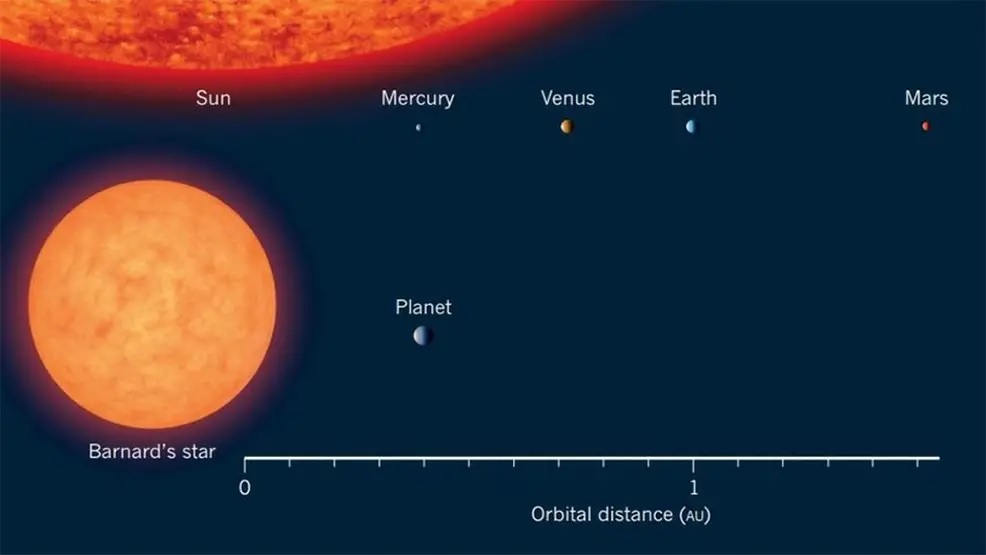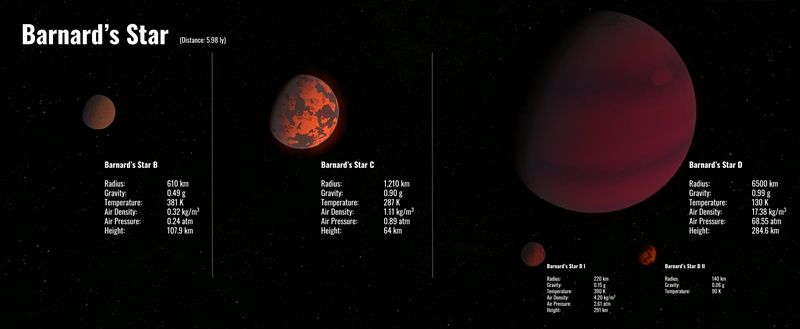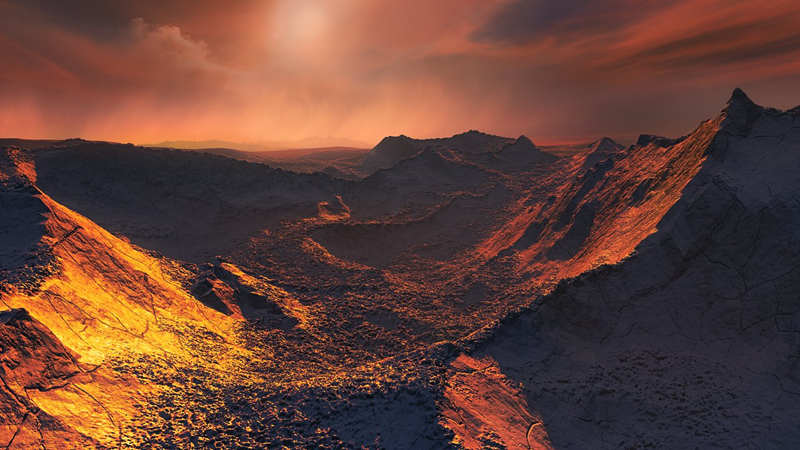Barnard’s Star is a red dwarf star located a mere 6 light-years away from Earth, making it the second-closest stellar system in the universe. In 2018, scientists confirmed the existence of a super-Earth within the Barnard’s Star system, named Barnard’s Star b. Despite its frigid surface, it may host geothermal activity, potentially creating subterranean oceans as potential habitats for life. This discovery has sparked further exploration into the possibility of extraterrestrial life forms in space. Here are 8 unique features of Barnard’s Star:
1. Barnard’s Star: Exploring a Super-Earth in the Universe
Barnard’s Star is a very small red dwarf star located just about 6 light-years away from Earth. It is the second closest stellar system to the Sun in the entire universe, with the first being the Alpha Centauri triple star system. It ranks as the fourth closest star to the Sun, with the top three being the three stars of the Alpha Centauri system. Astronomers have been debating the Barnard’s Star system for over half a century, and it wasn’t until November of 2018 that a team from the Carnegie Science Institute in the United States finally uncovered the truth, confirming the existence of a super-Earth within the Barnard’s Star system, known as Barnard’s Star b (or GJ 699 b).

2. Barnard’s Star b: The Mystery of a Potential Subsurface Ocean
Barnard’s Star b has a mass roughly three times that of Earth, orbits its host star every 233 days (similar to Mercury’s orbit around the Sun), and receives only 2% of the radiation Earth receives from the Sun. Its estimated surface temperature is around -170°C, placing it close to the snow line of the Barnard’s Star system, suggesting that the surface landscape of Barnard’s Star b is likely an icy wasteland. The Carnegie Science Institute team is not very hopeful about the possibility of life on this super-Earth.
However, other members of the team, including astrophysicists Edward Guinan and Scott Engle from Villanova University, who have been studying Barnard’s Star for the past 15 years, recently presented a more optimistic conclusion at the 233rd meeting of the American Astronomical Society (AAS): Barnard’s Star b has an iron/nickel core similar to Earth’s, which could enhance geothermal activity. Even if the surface of Barnard’s Star b is frozen, there may still be flowing subsurface oceans.
3. Barnard’s Star b: The Potential Ice Giant and the Mystery of Primitive Life
Edward Guinan suggests that the mass of Barnard b may be even greater than currently calculated, exceeding Earth’s mass by 7 times. With such mass, it could maintain a dense hydrogen and helium atmosphere, transforming it into an ice giant rather than a super-Earth. Coupled with tidal heating, there’s a possibility of finding primitive life beneath the ice layers. A similar scenario exists in Jupiter’s moon Europa in our solar system, where surface temperatures are similar to Barnard’s Star b. However, due to internal tidal heating, multiple observations indicate the presence of vast oceans beneath Europa’s icy surface. Currently, our understanding of Barnard’s Star b is limited. Astronomers eagerly await the future deployment of powerful telescopes for direct imaging of this super-Earth.

4. The Barnard Star System: Exploring Countless Planets in the Galaxy
In the near future, the Barnard star system will be a focal point for our survey and analysis efforts. One of the most significant features of Barnard’s Star is that it is one of the closest two-star systems to the Sun, harboring planets within. Co-author of the research report, Scott Engle, emphasizes that this study supports previous findings based on Kepler mission data, suggesting the prevalence of planets throughout the entire Milky Way, possibly numbering in the billions.
5. Barnard’s Star: Exploring the Mysteries of Planets Beyond the Sun
Barnard’s Star is approximately twice the age of the Sun, with an age of around 9 billion years, while the Sun is 4.6 billion years old. The birth of Earth-sized planets in the cosmos requires an extensive amount of time, even exceeding the current age of the Sun. Barnard’s b, with a mass three times that of Earth, orbits the red dwarf star Barnard with an orbital period of 233 days, at a distance roughly similar to Mercury’s orbit around the Sun. When it passes near the snow line of Barnard’s Star, it gradually darkens. Scott Engle stated, “These observational findings will aid us in understanding the atmospheres, surface structures, and potential habitability of exoplanets.”
6. Barnard b: Hope for Life Beneath the Ice?
Despite the surface temperature of Barnard b being approximately -150 degrees Celsius, scientists still believe that beneath its frozen exterior, there may be liquid water regions capable of nurturing life forms. This exoplanet is a rocky world with a volume at least 3.2 times that of Earth. Barnard’s Star is just 6 light-years away from Earth, making it incredibly close in astronomical terms, with a brightness only 0.0035 times that of the Sun. Currently, the closest star to the Sun is Alpha Centauri, which consists of three gravitationally bound stars and is located about 4 light-years away from Earth.
It is reported that the existence of Barnard b was discovered through observations over the past 20 years using various ground-based telescopes and astronomical instruments, including the “Carmenes” star hunting instrument at the Spanish Calar Alto Observatory. Even with the most powerful telescopes available today, direct imaging of Barnard b remains elusive.

7. Barnard’s Star: A Dim and Ancient Celestial Body
This is a dim and low-mass M4 dwarf star, with a brightness only 0.0035 times that of the Sun. Relevant radiation data indicates that its diameter is just 20% of the Sun’s, and its mass is only 17% of the nearest stars to the Sun. The majority of stars belong to the M-class dwarfs, which are extremely faint, much like the Alpha Centauri system, making them challenging to observe with the naked eye. Barnard’s Star is exceptionally ancient, originating during a period of explosive star formation when interstellar metal content had reached levels equivalent to only 10% of the Sun’s.
Its age also confirms a relatively long rotation period of 130 days, and as it ages, its rotation speed gradually decreases. In comparison, the Sun has an average rotation period of 25.4 days, which is approximately one-fifth of Barnard’s Star’s rotation period.
8. Barnard’s Star: Active Magnetic Fields and Incredible Longevity
Barnard’s Star still exhibits some level of magnetic field activity, occasionally erupting in flares driven by magnetic energy release. It possesses an active X-ray corona, similar to the Sun, with temperatures reaching up to 2 million Kelvin.
The low internal temperatures and meager energy generation rate of Barnard’s Star make it an incredibly long-lived “stellar elder.” In fact, no extinguished M-dwarf stars have been found in the Milky Way galaxy.
END:
After delving into the mysteries of the Barnard’s Star system and its planet, Barnard b, we have encountered a profoundly challenging cosmic environment and a universe filled with untapped possibilities. Barnard’s Star, despite being a mere six light-years away from Earth, has always been a source of fascination for astronomers. Its allure lies not only in its proximity but also in the enigmatic nature of the Barnard’s Star system.
Barnard’s Star b, a super-Earth with a mass roughly three times that of our planet, may appear frigid on the surface, but it holds the potential for a searing hot core and hidden reservoirs of liquid oceans. This discovery prompts us to ask even more questions about the existence of life in the cosmos and ignites our thirst for space exploration.
With the advancement of future astronomical observation technologies and space exploration missions, we are poised to gain deeper insights into the Barnard’s Star system and Barnard’s Star b. Perhaps, we may even have the opportunity to directly observe this super-Earth. This journey of exploration is rife with challenges, but it is equally brimming with hope. It will enable us to better fathom the mysteries of the universe and the potential for life beyond our home planet. Regardless of what lies ahead, Barnard’s Star will continue to captivate astronomers and space explorers, promising to unveil more astonishing discoveries about the cosmos.
More UFOs and mysterious files, please check out our YouTube channel: MysFiles
What NASA found on Mars in 2023? New Evidence of life on Mars?








